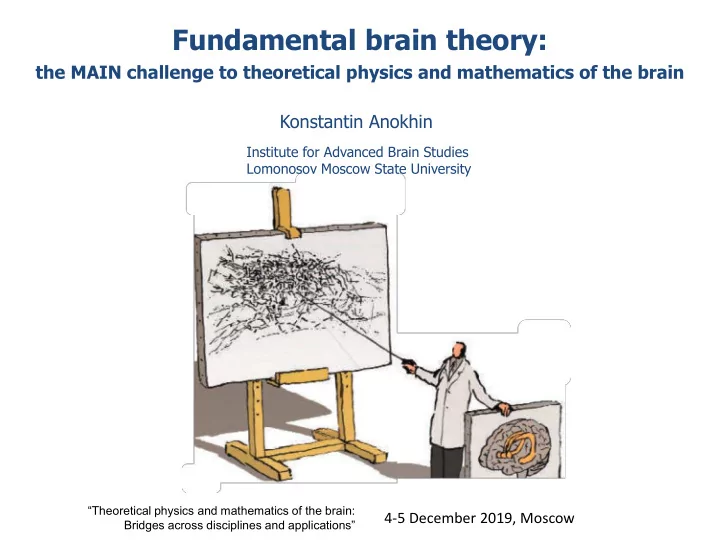

Fundamental brain theory: the MAIN challenge to theoretical physics and mathematics of the brain Konstantin Anokhin Institute for Advanced Brain Studies Lomonosov Moscow State University “Theoretical physics and mathematics of the brain: 4-5 December 2019, Moscow Bridges across disciplines and applications”
Current situation ₋ A burst of neuroscience research ₋ Leads to huge amount of data ₋ Is accompanied by lack of understanding ₋ And desperate need for a fundamental brain theory (FBT) Theoretical physics and mathematics of the brain
What are the requirements for FBT? FBT General Specific requirements requirements should explain should address three • • maximum (all) data major biological questions with minimum basic • principles and solve the MAIN • problem
General requirements “When we say that we understand a group of natural phenomena, we mean that we have found a constructive theory that embraces them.“ A. Einstein "The following requirement for a complete theory seems to be a necessary one: every element of physical reality must have a counterpart in the physical theory" A. Einstein, B.Podolsky, N.Rosen. Can quantum- mechanical description of physical reality be considered complete? Physical Review 47 (1935): 777f
Specific requirements: major biological questions “Biologists ask only three questions of a living organism: − How is it built? − How does it work? − And how did it get that way?” Sydney Brenner A. Through B. Through C. Through evolution development development (unique for brain)
Specific requirements: the MAIN problem “More is different” Philip Anderson (1972)
Specific requirements: The MAIN problem for FBT is M ind-br AIN problem Explanatory gap
Attempts (among physicists) Chapter 1. The Physical Basis of Consciousness “ A Tentative Answer I would summarize my general hypothesis thus: consciousness is associated with the learning of the living substance.”
Attempts (among physicists) "You, your joys and your sorrows, your memories and your ambitions, your sense of personal identity and free will, are in fact no more than the behavior of a vast assembly of nerve cells and their associated molecules. As Lewis Carroll's Alice might have phrased it: "you're nothing but a pack of neurons." F. Crick “ The Astonishing Hypothesis”, 1993
Attempts (among physicists) Orchestrated objective reduction (Orch OR) theory (R.Penrose and S. Hameroff) Consciousness is based on non-computable quantum processing performed by qubits formed collectively on cellular microtubules, a process significantly amplified in the neurons.
Attempts (among physicists) Integrated information theory (G.Tononi) “ IIT postulates that conscious experience is a fundamental aspect of reality and is identical to a particular type of information — integrated information. Tononi’s theory offers a scientific, constructive, predictive and mathematically precise form of panpsychism for the 21st century. It is a gigantic step in the final resolution of the ancient mind- body problem.”
CURRENT KNOWLEDGE Revolution in techniques • Brain facts • MAIN facts •
Revolution in techniques
Brain facts
Natural neural networks
Natural neural networks
Natural neural networks
Natural neural networks
Hippocampal neural network
Hippocampal neural network channels information from and to the cortex cortex (4-6) cortex (2-3) from Lichtman et al.
Hippocampal neural network of learning neurons c-Fos whole-mount immunohistochemistry of the mouse hippocampus after fear conditioning A.Lazutkin et al., 2008
Any brain is connectome “To understand the functioning of a network, one must know its elements and their interconnections. The purpose of this article is to discuss research strategies aimed at a comprehensive structural description of the network of elements and connections forming the human brain . We propose to call this dataset the human “ connectome ” .” Sporns et al. , (2005), ” The Human Connectome, a structural description of the human brain”
Analysis of connectomes Bullmore E. and Sporns O ., Nature Reviews, Vol.10, 2009
MAIN facts Cognitive specialization of neurons “In any field find the most unusual fact and then explore it” J.A. Wheeler
Implantation sites in the patient brain From Quiroga et al., 2009
Cognitive specialization of neurons in the human brain “ Bill Clinton neuron" Kreiman et al., Proc Natl Acad Sci U S A. 2002. 99(12):8378-83.
Cognitive specialization of neurons in the human brain “ Saddam Hussein neuron" Kreiman et al., Proc Natl Acad Sci U S A. 2002. 99(12):8378-83.
Cognitive specialization of neurons in the human brain “ Luke Skywalker neuron" From: R.Q. Quiroga (2012) Nat.Rev. Neurosci
Cognitive specialization of neurons in the human brain “ Jennifer Aniston neuron" J. Aniston with a J. Aniston alone Husband – Brad Pitt Quiroga et al., Nature. 2005. 435 (7045) 1102-7
Cognitive specialization of neurons in the human brain LT LT SO LT S О S О S О S О S О S О Sydney Opera Lotus Temple New Delhi LT Quiroga et al., Nature. 2005. 435 (7045) 1102-7
Cognitive specialization of neurons in the human brain
Cognitive specialization of neurons in the animal brain • It is extremely difficult to study these processes in the human brain. • However, similar phenomena exists in the animal brain. V.B.Shvyrkov, "Systems determination of neuronal activity during behavior" Adv.Physiol.Sci, 14 (1983) 1-27.
Averkin et al., 2002
Summary of requirements FBT should: account for plethora (all) neuroscience facts, ▪ AND explain consciousness, ▪ using minimal basic assumptions. ▪
Three tentative first principles: GIN FUS NEM Global Functional Network Integrative Systems Memory Network Repeat … Mind
Thank you for attention!
Recommend
More recommend